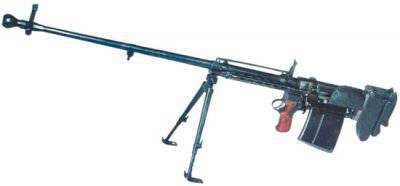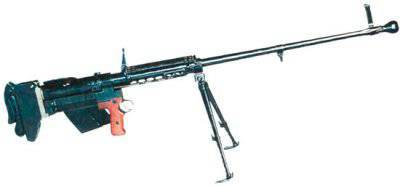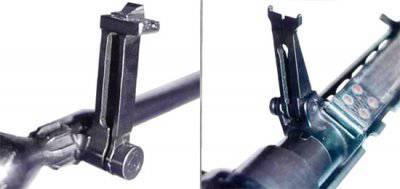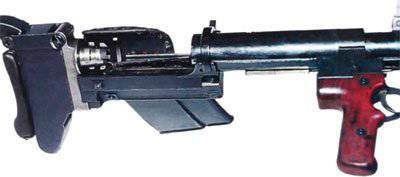W / 7,92 - anti-tank rifle from Czechoslovakia
 Work on the creation of anti-tank guns in Czechoslovakia began quite late, much later than they should have started in a country with a fairly well-developed production of firearms. Requirements for the MFR were formulated only at the beginning of the 1930-ies and the designers immediately began to work. The task was complicated by the fact that, in addition to weapons, it was also necessary to make ammunition with sufficiently high armor-piercing characteristics, and this moment required separate attention and a lot of time, since it was the ammunition that sets the main characteristics of the weapon, which means that an error in designing the cartridge would put all the work in vain.
Work on the creation of anti-tank guns in Czechoslovakia began quite late, much later than they should have started in a country with a fairly well-developed production of firearms. Requirements for the MFR were formulated only at the beginning of the 1930-ies and the designers immediately began to work. The task was complicated by the fact that, in addition to weapons, it was also necessary to make ammunition with sufficiently high armor-piercing characteristics, and this moment required separate attention and a lot of time, since it was the ammunition that sets the main characteristics of the weapon, which means that an error in designing the cartridge would put all the work in vain. With the caliber of ammunition decided quickly enough. After the initial tests, it was clear that you should not take up arms with huge calibers, and it is better to give preference to smaller bullets with good speed and armor-piercing. Given that the plans did not create perversions with high-explosive fragmentation bullets in the caliber 20 of millimeters, such a decision was quite logical. It is the work on the creation of a new ammunition and explains the delay in the development of anti-tank gun. Unfortunately, the new ammunition did not appear, since in the 1939 year the Germans began to be in charge of production, who considered it inexpedient to create a new cartridge, and in its place was taken the time-tested 7,92х94, also known as Patrone 318.
With the caliber of ammunition decided quickly enough. After the initial tests, it was clear that you should not take up arms with huge calibers, and it is better to give preference to smaller bullets with good speed and armor-piercing. Given that the plans did not create perversions with high-explosive fragmentation bullets in the caliber 20 of millimeters, such a decision was quite logical. It is the work on the creation of a new ammunition and explains the delay in the development of anti-tank gun. Unfortunately, the new ammunition did not appear, since in the 1939 year the Germans began to be in charge of production, who considered it inexpedient to create a new cartridge, and in its place was taken the time-tested 7,92х94, also known as Patrone 318.Frankly speaking, this ammunition was not the best, but not the worst, this cartridge was used in the German anti-tank guns PzB 38 and PzB 39. It is understandable why the creation of a new patron was considered inexpedient. Under this munition, other samples of the PTR were already actively used, and another new cartridge could be put into service, which, perhaps, would be slightly better is not really the best idea. As a result, the characteristics of the weapon were already known in advance, although the weapon itself was not yet. A relatively light bullet weighing 14,6 grams accelerated to speeds in excess of 1200 meters per second. With such weight and speed at a distance of 400 meters, it flew virtually in a straight line, which greatly facilitated aiming, and therefore increased the practical rate of fire, not to mention the effectiveness of the fire, especially for moving targets. Armor-piercing characteristics of the cartridge for those times were quite good. For example, an ammunition bullet easily pierced 30 millimeters of armor at a distance of 100 meters, while increasing the firing distance to 300 meters, the bullet could pierce only 25 millimeters of armor. So for the end of the 30-s, given the level of development of armored vehicles, this ammunition was really good.
 Despite the fact that the Germans covered part of the development project and the ammunition and PTR, the anti-tank gun itself was very interesting for them. The interest was due to the fact that the weapons were going to be made in the bullpup layout, and therefore more compact compared to the German samples of anti-tank guns for Patrone 318 ammunition. The prospect of more compact weapons with the same efficiency was quite clear, such a sample of weapons would be more convenient when used in cramped conditions, that is, the fire could be conducted from fortified shelters and even from armored vehicles. And this has already significantly expanded the capabilities of the PTR as a whole. In addition, do not forget that the eternal problem of anti-tank guns were the size, weight and impact when shooting. In this case, it was proposed to reduce at least one weapon deficiency.
Despite the fact that the Germans covered part of the development project and the ammunition and PTR, the anti-tank gun itself was very interesting for them. The interest was due to the fact that the weapons were going to be made in the bullpup layout, and therefore more compact compared to the German samples of anti-tank guns for Patrone 318 ammunition. The prospect of more compact weapons with the same efficiency was quite clear, such a sample of weapons would be more convenient when used in cramped conditions, that is, the fire could be conducted from fortified shelters and even from armored vehicles. And this has already significantly expanded the capabilities of the PTR as a whole. In addition, do not forget that the eternal problem of anti-tank guns were the size, weight and impact when shooting. In this case, it was proposed to reduce at least one weapon deficiency. It was decided to make the device non-autonomous, to increase accuracy and durability, as well as to reduce the cost of production of PTR. However, the weapon was not as simple as it might seem. The German gunsmiths, who offered to reload the weapon while moving the pistol grip back and forth, made their contribution. Czechoslovak gunsmiths, in turn, simplified the design to impossible. So, together with the pistol grip, the receiver and barrel of the weapon moved, but the bolt itself was fixed and was assembled as a separate part in the butt. This design really allowed to significantly reduce the dimensions of the weapon while maintaining the normal length of the barrel, and to such an extent that this version of the anti-tank gun can rightfully be considered one of the smallest. The final version of the anti-tank gun weighed 13,1 kilogram and at the same time had a length of 136 centimeters with a barrel length 110 centimeters. The apparatus was fed from detachable box stores with a capacity of 5 or 10 cartridges. Separately, it is worth noting that due to the original solution with reloading weapons, the practical rate of fire of an anti-tank gun could reach 20 rounds per minute, which is a very good result for a non-self-loading sample.
It was decided to make the device non-autonomous, to increase accuracy and durability, as well as to reduce the cost of production of PTR. However, the weapon was not as simple as it might seem. The German gunsmiths, who offered to reload the weapon while moving the pistol grip back and forth, made their contribution. Czechoslovak gunsmiths, in turn, simplified the design to impossible. So, together with the pistol grip, the receiver and barrel of the weapon moved, but the bolt itself was fixed and was assembled as a separate part in the butt. This design really allowed to significantly reduce the dimensions of the weapon while maintaining the normal length of the barrel, and to such an extent that this version of the anti-tank gun can rightfully be considered one of the smallest. The final version of the anti-tank gun weighed 13,1 kilogram and at the same time had a length of 136 centimeters with a barrel length 110 centimeters. The apparatus was fed from detachable box stores with a capacity of 5 or 10 cartridges. Separately, it is worth noting that due to the original solution with reloading weapons, the practical rate of fire of an anti-tank gun could reach 20 rounds per minute, which is a very good result for a non-self-loading sample. Unfortunately, the weapon was not without negative aspects. The most important of them was just the way to implement recharge. The shutter was exactly under the cheek of the shooter and even the cheek rest did not save the situation. So frequent occurrence was getting clothes, and sometimes the skin in the moving parts of the weapon, which caused delays when firing. For this reason, during reloading it was worth keeping your face away from the weapon, which was not very convenient.
Unfortunately, the weapon was not without negative aspects. The most important of them was just the way to implement recharge. The shutter was exactly under the cheek of the shooter and even the cheek rest did not save the situation. So frequent occurrence was getting clothes, and sometimes the skin in the moving parts of the weapon, which caused delays when firing. For this reason, during reloading it was worth keeping your face away from the weapon, which was not very convenient. The problem with kickback when shooting was solved by a rather large muzzle brake-compensator of kickback, as well as a shock-absorbing butt pad. True, the PTR still kicked out quite strongly, but it still had quite good accuracy of fire and could be used to fire at a distance of up to 500 meters, even according to the strength of the enemy. Perhaps in the case of installing an optical sight, this distance would have been even greater, but given the high recoil when shooting, using optics, which literally became one-time was not the best solution.
The German army received this weapon in the 1941 year under the name PzB M.SS 41, while the Czechoslovak name of the anti-tank gun remained W / 7,92.
Information